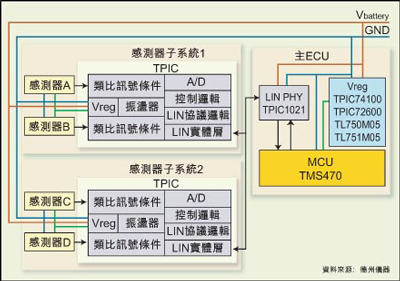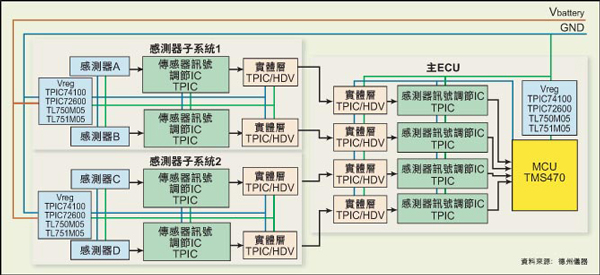As automotive electronic systems progress, the need for low cost, high reliability sensor systems is becoming increasingly important. While there are many challenges to overcome to meet these needs, advances in interconnect architecture and mixed-signal processes have dramatically increased intelligence, reduced cost, and increased reliability. Moreover, more advanced technologies are constantly coming out.
This article refers to the address: http://
Currently, most sensor systems are based on an architecture where the main electronic control unit (ECU) from the sensor to the system is an analog signal chain. Maintaining the signal integrity of these systems is a challenge in extremely noisy automotive environments.
One solution is to digitally transmit signals on different physical layers using simple, proprietary techniques such as pulse width modulation (PWM) or variable pulse width. But these methods have several drawbacks. In general, each signal requires a separate line, and the information is usually unidirectional output from the sensor to the main ECU. It is therefore impossible to use this sensor subsystem for two-way communication and diagnostics.
Another option is to use the CAN bus to transmit signals back to the main ECU. However, this approach typically requires a microcontroller and support circuitry, which adds considerable cost.

Figure 1: LIN-based sensor system architecture.
There are currently two technology trends driving the development of automotive sensor systems: advances in regional interconnect network (LIN) protocols and mixed-signal semiconductor process technologies.
Although LIN was originally aimed at body electronics, it has been creatively applied to new aspects, such as the sensor interface. Several features of LIN make it suitable as a physical layer and protocol for the sensor subsystem. This is a low-cost, two-way, single-wire physical layer implementation that reduces the need for signal lines and their harnesses. If the module contains more than one sensor, the advantages of this method can be highlighted, and all outputs can be implemented on a single LIN bus through multiplexing.
LIN-based sensor system architecture
The LIN protocol is based on a master-slave architecture in which all bus communication is controlled and scheduled by the master node. This feature provides guaranteed latency for signal transmission, making the system predictable, which is absolutely necessary for most sensor signals. The LIN bus architecture can be extended to 16 nodes and does not require an arbitration mechanism because all bus traffic is scheduled by the master node.
The slave nodes are self-synchronizing and can replace the crystal or ceramic resonator with an on-wafer RC oscillator, thus significantly reducing cost at the system level. The protocol is very simple and standardized for asynchronous serial interface (UART/SCI). In addition, the cost of implementation is quite low, even with mixed signal processing typically used for sensor signal interface ICs. Through standardization, LIN-based sensor subsystems reduce costs and increase reliability.
The continuous development of mixed-signal semiconductor processes has led to an increasing level of integration, especially in terms of digital integration and analog precision. Several processes are currently available for automotive sensor applications such as linear BiCMOS, high voltage CMOS and SOI. Each process has its advantages and disadvantages, depending on the type of sensor and application needs.
These processes allow the implementation of electronic components of the entire sensor system with a single-chip SoC, including power supplies, high-voltage operation, digital circuitry, memory, clock sources, and high-precision analog circuits.

Figure 2: Current sensor system architecture.
Mixed signal interface IC
Some of Texas Instruments' custom mixed-signal ASIC sensor interface ICs use a mixed-signal semiconductor process and a LIN communication bus. This single-chip sensor interface IC integrates almost every component that needs to be connected to the sensor, the automotive electronics network, and the LIN bus. Typical components in these components include automotive voltage regulators for matching sensor and system requirements, analog filter front ends for direct connection to sensor outputs, an analog-to-digital converter, digital filtering and control, and a LIN protocol control. And the LIN entity layer.
By changing the architecture of the sensor system, using LIN as the signal and communication interface, and implementing it based on a mixed-signal IC, we can achieve several advantages at the system level. LIN allows two-way communication on a single line, so the master node can request the sensor to provide diagnostic information, or the sensor can provide system fault information when needed.
The LIN protocol and the physical layer are open specifications designed by the LIN Alliance for automotive applications. Recently, the American Society of Automotive Engineers added some good examples for LIN applications based on the J2602 specification, removing the dedicated interface and protocol, thus enabling sensor reuse and making them based on known, reliable and robust Communication system.
Even if the module contains multiple sensors, it is possible to make a sensor module with only three wires (battery, ground, and LIN). Reducing the wire and harness can reduce the package size of the sensor, optimize the layout of the sensor, and reduce wiring sensitivity.
Implementing sensor interface ICs using advanced mixed-signal process technology can reduce system cost in several ways: fewer components; less inventory; smaller, simpler PCB design; smaller sensor form factor and Higher reliability. Moreover, since a RC oscillator on the wafer is used, a crystal or resonator as a clock source can be omitted.
These advances are only a few small steps in improving the intelligence and performance of automotive sensor systems. The next generation of mixed-signal processes (such as LBC5 and LBC7) can integrate more intelligence and functionality into the sensor subsystem. We can even imagine that the next-generation sensor interface IC will include a small integrated microprocessor that provides program functionality to the sensor subsystem and adds flexibility.
iPhone XR Tempered Glass compatible with iPhone XR 2018. Explosion-proof 9H hardness scratch-resistant Screen Protector can effectively protect your iPhone XR from high impact drops, scratches, scrapes, bumps, puncture. High-definition clear hydrophobic and Oleophobic screen coating protects against sweat and oil residue from fingerprints. 2.5D or 3D smooth arc edge is not scratch your fingers.
Description of iPhone XR Tempered Glass
Size: 6.1 inch
For iPhone XR
Material: Corning, Schott or AGC
Radian: 2.5D / 3D
Technology: Clear / Anti glare / Anti blue light / Privacy / Printing
MOQ: 1K pieces
Packaging: Standard export package or Customized
Payment: T/T, Paypel, Others
Delivery: In Shenzhen CHINA, 2.5D: 7-10 working days / 3D: 15-20 working days after your payment
FAQ:
Q1: Are you a trading company or manufacturer?
---A: We are distributor located in Shenzhen, China.
Q2: Is the sample free?
---A: Yes, the free sample will be sent for your evaluation!
Q3: What is the production lead time?
---A: 2.5D: 7-10 working days / 3D: 15-20 working days after your payment.
Q4: Do you inspect all your goods before delivery?
---A: Yes, we have 100% inspect before delivery.
Welcome to make inquiry !
IPhone XR Tempered Glass
IPhone XR Tempered Glass,2.5D IPhone XR Tempered Glass,9H IPhone XR Tempered Glass,Tempered Glass For IPhone XR
Shenzhen Kantou IM Technology Co., Ltd. , https://www.kantou-im.com